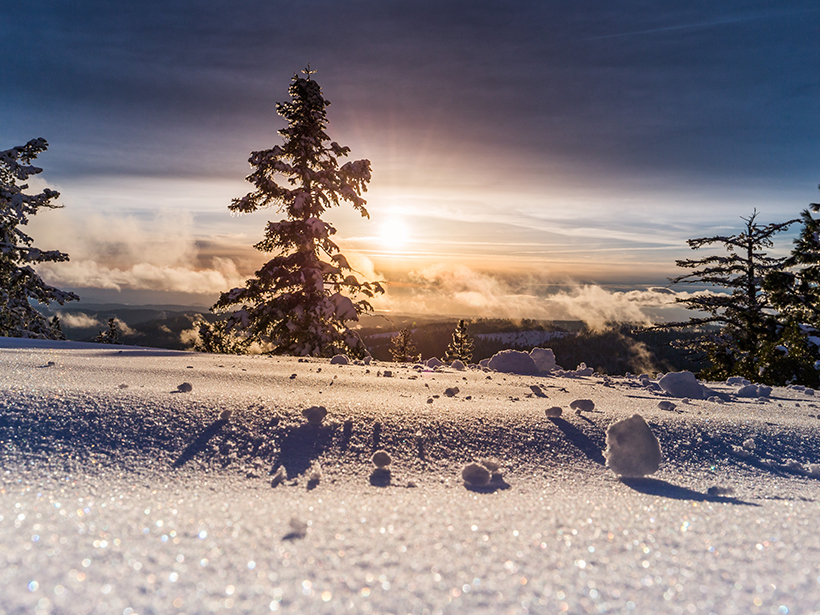Skiers are in their element the moment temperatures start to fall—gear out, tire chains at the ready, and eager for the first snowflakes to float down from the sky.
Snow season is a popular time in the western United States, but winter precipitation does more than create a playground for outdoor enthusiasts. Winter snowpacks provide much-needed water for arid and populated Western states, and in a warming climate, these snowpacks are at risk.
Three hour-long cloud-seeding events created the snow equivalent of about 282 Olympic-sized swimming pools’ worth of water.
For almost 100 years, scientists have been working on a way to seed clouds, forcing them to drop their floating moisture. Seeding works, but scientists have found it difficult to quantify just how much precipitation is a result of cloud-seeding events.
In a new study, scientists were able to measure the amount of snow generated from cloud seeding over an area in western Idaho. Using radar and gauges on the ground, the team calculated that three hour-long seeding events created snow equivalent to about 282 Olympic-sized swimming pools’ worth of water.
This work is an important step in understanding how effective cloud seeding might produce much-needed water in the arid and mountainous West.
Coaxing Precipitation from Cloud Seeding
Seeding clouds in mountainous regions, or orographic cloud seeding, has the potential for increasing water storage in dry areas. During orographic seeding, silver iodide (AgI) is released from an airplane or flares. Tiny, supercooled water droplets in the atmosphere crystalize around the AgI droplets, eventually merging and becoming heavy enough to fall out of the sky.
But the efficacy of artificially coaxing water out of the sky has been a mystery. “Despite cloud seeding being conducted for almost a hundred years, we had difficulties quantifying how much water we can get out of these clouds,” said Katja Friedrich, an atmospheric scientist at the University of Colorado Boulder and lead author of the new paper in the Proceedings of the National Academy of Sciences of the United States of America.
Friedrich said the biggest problem is distinguishing natural precipitation from what is generated from cloud seeding. In the past, scientists statistically compared the results of a cloud-seeding event to precipitation on a nonseeding day.
Measuring Snowfall
Friedrich said her team’s monitoring method allowed them to see unambiguous evidence that significant precipitation was generated from cloud seeding.
Weather radar tracked the generation and intensity of precipitation while gauges on the ground measured snowfall.
The team traveled to Idaho’s Payette Basin to measure precipitation resulting from three cloud-seeding events. Weather radar tracked the generation and intensity of precipitation while gauges on the ground measured snowfall. Snow ranging from 0.05 to 0.3 millimeters fell to the ground after the seeding events.
“In total, we generated water that’s equivalent to 282 Olympic-sized swimming pools,” said Friedrich.
In addition to the measurements of snow, Friedrich noted that her team learned how the distributions of snow changed on the basis of atmospheric conditions. For example, on the third day of seeding, high winds and turbulent conditions caused precipitation to spread out over a large area.
“I think what is interesting about this study is that they were able to take a very still-pressing question, which is whether or not cloud seeding is an effective way of increasing precipitation, and apply cloud research tools to try to effectively answer that question,” said Gannet Hallar, director of the Storm Peak Laboratory at the Desert Research Institute in Steamboat Springs, Colo. She was not part of the new study.
Hallar said although the study was an impressive and carefully designed investigation, “the limitation is that these are only case studies.” She added that there are still unanswered questions about how spatial and temporal variables in the atmosphere affect precipitation from cloud seeding.
“It’s one thing to increase precipitation at a given point; it’s another thing to increase precipitation over a basin scale,” said Hallar. She noted that expanding the cloud seeding research to another orographic area would be a logical next step in understanding how to create targeted precipitation. “There’s still quite a bit of research to be done,” she said.
Friedrich agreed with Hallar and said there are a lot of unanswered questions.
The team’s next steps include more scientific analyses of their data, including understanding the water year with and without cloud seeding and how much of the water would get stored in stream and reservoir systems.
—Sarah Derouin (@Sarah_Derouin), Science Writer
Citation:
Derouin, S. (2020), Researchers quantify a seeded snowpack, Eos, 101, https://doi.org/10.1029/2020EO141338. Published on 11 March 2020.
Text © 2020. The authors. CC BY-NC-ND 3.0
Except where otherwise noted, images are subject to copyright. Any reuse without express permission from the copyright owner is prohibited.

